

Cerberus. Cerberus /ˈsɜrbərəs/,[1] or Kerberos, (Greek form: Κέρβερος, [ˈkerberos])[2] in Greek and Roman mythology, is a multi-headed (usually three-headed) dog, or "hellhound" [1][3][4] with a serpent's tail, a mane of snakes, and a lion's claws.[5] He guards the entrance of the underworld to prevent the dead from escaping and the living from entering.

Cerberus is featured in many works of ancient Greek and Roman literature and in works of both ancient and modern art and architecture, although the depiction of Cerberus differs across various renditions. The most notable difference is the number of his heads: Most sources describe or depict three heads; others show Cerberus with two or even just one; a smaller number of sources show a variable number, sometimes as many as 50 or even 100. Hades. Names and epithets.
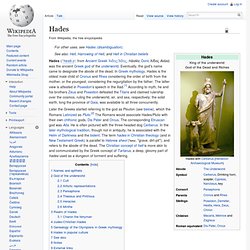
Witchcraft. The belief in and the practice of magic has been present since the earliest human cultures and continues to have an important religious and medicinal role in many cultures today.[1] "Magic is central not only in 'primitive' societies but in 'high cultural' societies as well...

"[2] The concept of witchcraft as harmful is often treated as a cultural ideology providing a scapegoat for human misfortune.[3][4] This was particularly the case in the early modern period of Europe where witchcraft came to be seen as part of a vast diabolical conspiracy of individuals in league with the Devil undermining Christianity, eventually leading to large-scale witch-hunts, especially in Protestant Europe. Hel (being) From Wikipedia, the free encyclopedia Hel may refer to: HEL may refer to:
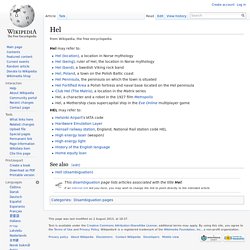
Black magic. History[edit] Like its counterpart white magic, the origins of black magic can be traced to the primitive, ritualistic worship of spirits as outlined in Robert M.

Place's 2009 book, Magic and Alchemy.[3] Unlike white magic, in which Place sees parallels with primitive shamanistic efforts to achieve closeness with spiritual beings, the rituals that developed into modern "black magic" were designed to invoke those same spirits to produce beneficial outcomes for the practitioner. Place also provides a broad modern definition of both black and white magic, preferring instead to refer to them as "high magic" (white) and "low magic" (black) based primarily on intentions of the practitioner employing them. Hecate. Ancient Greek goddess of magic and crossroads Hecate was one of the main deities worshiped in Athenian households as a protective goddess and one who bestowed prosperity and daily blessings on the family.[5] In the post-Christian writings of the Chaldean Oracles (2nd–3rd century CE) she was regarded with (some) rulership over earth, sea, and sky, as well as a more universal role as Savior (Soteira), Mother of Angels and the Cosmic World Soul.[6][7] Regarding the nature of her cult, it has been remarked, "she is more at home on the fringes than in the center of Greek polytheism.

Circe. Medea. Heraclitus. Heraclitus of Ephesus (/ˌhɛrəˈklaɪtəs/;[1] Greek: Ἡράκλειτος ὁ Ἐφέσιος, Hērákleitos ho Ephésios; c. 535 – c. 475 BCE) was a pre-Socratic Greek philosopher, a native of the Greek city Ephesus, Ionia, on the coast of Asia Minor.
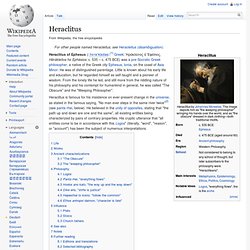
He was of distinguished parentage. Little is known about his early life and education, but he regarded himself as self-taught and a pioneer of wisdom. Semiramis. Semiramis depicted as an armed Amazon in this eighteenth-century Italian illustration.
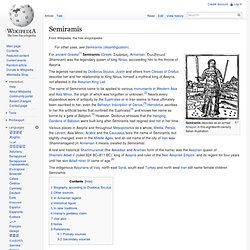
Mary the Jewess. Engraving depicting Maria Prophetissima from Michael Maier's book Symbola Aurea Mensae Duodecim Nationum (1617).
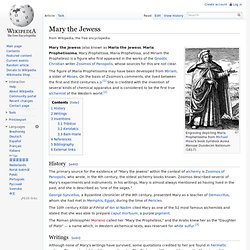
Mary the Jewess (also known as Maria the Jewess, Maria Prophetissima, Mary Prophetissa, Maria Prophetissa, and Miriam the Prophetess) is a figure who first appeared in the works of the Gnostic Christian writer Zosimos of Panopolis, whose sources for this are not clear. Solomon. According to the Talmud, Solomon is one of the 48 prophets.[4] In the Qur'an, he is considered a major prophet, and Muslims generally refer to him by the Arabic variant Sulayman, son of David.
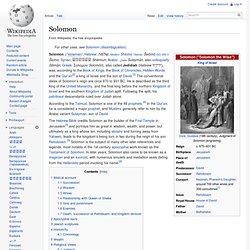
Biblical account[edit] Succession[edit] Cornelis de Vos, The Anointing of Solomon . According to 1 Kings 1:39, Solomon was anointed by Zadok. According to the biblical First Book of Kings, when David was old, "he could not get warm Adonijah asked to marry Abishag the Shunammite, but Solomon disallowed that, although Bathsheba now pleaded on Adonijah's behalf. Wisdom[edit] Artist's depiction of Solomon's court (Ingobertus, c. 880) One of the qualities most ascribed to Solomon is his wisdom. "And the king went to Gibeon to sacrifice there; for that was the great high place: a thousand burnt offerings did Solomon offer upon that altar.
William Blake. William Blake (28 November 1757 – 12 August 1827) was an English poet, painter, and printmaker. Largely unrecognised during his lifetime, Blake is now considered a seminal figure in the history of the poetry and visual arts of the Romantic Age. His prophetic poetry has been said to form "what is in proportion to its merits the least read body of poetry in the English language".[2] His visual artistry led one contemporary art critic to proclaim him "far and away the greatest artist Britain has ever produced".[3] In 2002, Blake was placed at number 38 in the BBC's poll of the 100 Greatest Britons.[4] Although he lived in London his entire life (except for three years spent in Felpham),[5] he produced a diverse and symbolically rich oeuvre, which embraced the imagination as "the body of God"[6] or "human existence itself".[7] Early life[edit] 28 Broad Street (now Broadwick Street) in an illustration of 1912.
Blake was born here and lived here until he was 25. Apprenticeship to Basire[edit] W. B. Yeats. Life[edit] Early years[edit] An Anglo-Irishman,[4] William Butler Yeats was born in Sandymount, County Dublin, Ireland.[5] His father, John Butler Yeats (1839–1922), was a descendant of Jervis Yeats, a Williamite soldier, linen merchant, and well known painter who died in 1712.[6] Jervis's grandson Benjamin married Mary Butler[7] of a landed family in County Kildare. At the time of his marriage, John Yeats was studying law but abandoned his studies to study art at Heatherley's Art School in London.[8] His mother, Susan Mary Pollexfen, came from a wealthy merchant family in the county town Sligo, County Sligo, who owned a milling and shipping business. Soon after William's birth the family relocated to the Pollexfen home at Merville, Sligo to stay with her extended family, and the young poet came to think of the area as his childhood and spiritual home.